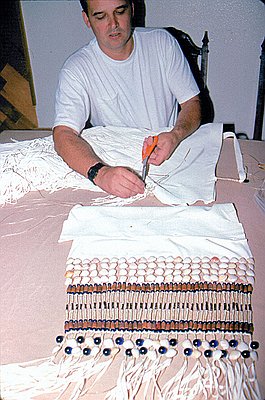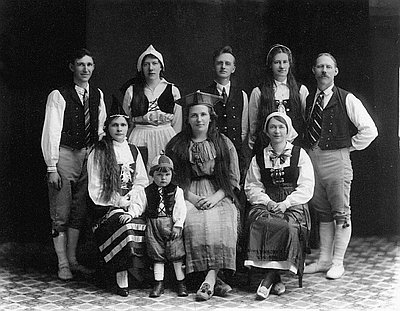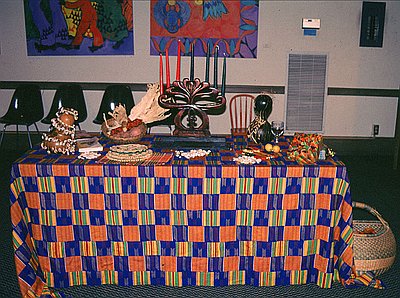The Oregon Coast
The word “tradition” comes from the Latin tradere, “to hand over, to deliver.” It may seem to imply a static, unchanging state, yet folklife and folk art forms are equally expressive of change. The human urge to make beauty from daily life shifts and adapts to social, economic, and political circumstances. Fishing traditions, logger poetry, quilting, Norwegian rosemaling, and Irish fiddling form a vital mix of contemporary folk art forms flourishing on the Oregon Coast. All reflect the different worldviews of still-thriving cultures, the shifting economy of our state, and the tensions that sometimes arise in communities.
We may think of nature and culture as separate forces, yet each shapes the other. On the Oregon Coast, folklife is most visible in the human adaptation to the sea and rivers. A vibrant fishing culture links Native Americans to more recent inhabitants. With updated technology, Native people still fish for the species that sustained their ancestors. European immigrants brought their own maritime methods, beliefs, and folklife—evident today in fish smoking, knot-tying, boat-launching celebrations, and verbal arts such as fisher poetry.
While folk arts may connect diverse groups, they also reveal fissures and divisions, particularly in our views of nature and culture. Euro-Americans more often value control and regulation of nature, while indigenous people traditionally view the natural world as one to which we have reciprocal responsibilities. Today, as we react to our threatened natural environment, these different worldviews overlap and occasionally collide in the “contact zone” of difference. Our challenge is to honor diversity while finding common ground in shaping environmental and social policy. Folklorists can aid cultural conservation by research into how people interpret their environment and by helping communities sustain their resources. An adjacent challenge is to honor the fluid and complex nature of cultures, staying away from facile stereotypes of Native Americans as “natural ecologists” and whites as “natural exploiters.”
Imagine the scene. On a winter night in an Alsean village on Oregon’s central coast, elders shared tales around a fire with visitors from a nearby Yaquina village. Each would have belonged to one of a multitude of bands speaking nearly twenty local languages that flourished in the region in the eighteenth century. Oral tradition gave birth to over ten thousand tales told to entertain and instruct. Few of those languages were mutually intelligible. While visitors from Yaquina could understand Alsean elders, coastal groups speaking Chinookan, Salishan, Siuslaw, and other languages needed a lingua franca. A hybrid language developed that was both utilitarian and rich in metaphor. The basic vocabulary for Chinook Jargon, called Chinuk Wawa by local Indians, was Chinookan, augmented by Nuu-chah-nulth, English, and French loan words. Terms for objects that were unknown to local people, such as “fork,” found form through relationship—opitsah yakha sikh ‘friend to the knife’.
Material arts among indigenous people on the coast mirrored linguistic creativity. Cedar bark torn into strands was made into a woman’s cape, a dress, or a man’s breechcloth. Gathered and harvested shells adorned clothing for ritual and ceremony. Archaeologists have found much evidence of beauty married to necessity, the hallmark of folk arts.
Imagine another scene, this one in 2004. At the Siletz Reservation, young people prepared the ground for a traditional dance. The smell of frybread filled the air as a group began to perform. For weeks before the event, Alfred “Bud” Lane III prepared Tututni shell dresses. Lane served three times as a master artist with the Traditional Arts Apprenticeship Program of the Oregon Folklife Program. He passed on knowledge of how to make a shell dress and taught basket weaving and how to create a baby basket. Lane searched throughout Oregon and California for Tututni Indians who remembered how to create a shell dress and then pursued a ten-year apprenticeship. The Siletz may not need baskets to store food as they once did, but they may seek this knowledge for another kind of survival—to understand who they are.
Lane knew about cultural survival, for his heritage was nearly destroyed. The Siletz Reservation is an amalgam of twenty-seven bands who were forced onto a reservation of 1.3 million acres by the U.S. government in the mid-nineteenth century, which was then gradually reduced in size. In 1954, these bands lost their land along with their tribal status during a period of U.S. Indian policy referred to as termination. In the governmental effort to assimilate the Siletz and other Native people into white mainstream America, many traditional practices, languages, and other forms of cultural expression were lost. With the restoration of the Sieltz tribe in 1977, Bud Lane and others began to revive cultural knowledge. Especially important are public events like powwows, pan-Indian celebrations featuring music and dance. “Survival” has a different face in the twenty-first century, as cultures become blends of past and present, of creative reconstruction and preservation.
An equally important form of revival is that of indigenous languages. Language is a life force within culture—the source of oral poetry, stories, and everyday folk speech. Many indigenous languages were destroyed during colonization and the many years of forced assimilation. You can hear Chinook Wawa spoken by a new generation today, for example. Not far from Spirit Mountain, the casino on the Grand Ronde Reservation, children at the tribal educational center read from Golden Books with terms in Chinuk Wawa pasted over the English text. Some Chinookan words, such as skookum ‘strong or powerful’, have entered Oregon’s folklore, appearing in stories, as place-names, and as the names of boats and restaurants. Yet, the continuation of Chinuk Wawa and the many other indigenous languages spoken in Oregon is hardly ensured. Linguists predict that between 20 and 50 percent of the world’s six thousand languages will disappear during the twenty-first century. Of the 175 indigenous languages currently spoken in the United States, only twenty likely will remain by the year 2050. Unless steps are taken to counter this trend, we will lose the unique knowledge embedded in different languages. Revived linguistic and folk art forms reflect a world of complexity: the tragedies of colonial encounters, the creativity and resilience of Native people, and the elasticity of culture.
Euro-American settlement introduced a myriad of additional cultures and folk arts to the Oregon Coast. Many Oregonians descend from immigrants who fled Ireland in the mid-nineteenth century during the Great Famine, a reminder that migration is often forced by economics and politics. The ethnic identity of the Irish diaspora continues on the coast and elsewhere in music, including songs, instrument making and playing, and dance. In Florence, Thomas McCreesh played Irish fiddle tunes he learned in childhood, blending music, poetry, and storytelling in performances. In Ireland, the bard tradition happened in the local pub, while McCreesh performed in community centers and schools. “My roots in Ireland are very deep, very important to me,” he said.
Astoria, one of the oldest American settlements in the West, has been home to Asian and European immigrants for well over a century. Scandinavian cultures have thrived in the Finnish sauna downtown and in the Scandinavian Midsummer Festival. Danes, Swedes, Finns, Norwegians, and Icelanders have gathered each year to eat lefsa, a Norwegian flat bread and lutefisk, fish soaked in lye. There is a “troll stroll,” a hex-burning bonfire, and displays of Norwegian hardanger, a form of embroidery worked in white yarn on white or colored cloth using drawn thread work. Visitors from contemporary Scandinavian countries might find folk art forms here that no longer live in their country; people who migrate out sometimes feel more attached to tradition than those who stay behind.
Farther down the coast in Gold Beach, JoAnn Fedje practiced another tradition revived in a new context—rosemaling. While art forms can be passed down in families, others are sought by adults to connect to an otherwise lost heritage. Fedje learned rosemalingwhile attending a family reunion in Norway. Itinerant painters in the nineteenth century developed this style of painting, originally done on walls, ceilings, and furniture in rural homes. Today, rosemaling appears on wooden spoons, bowls, chests, furniture, and even mailboxes.
If one activity could define the folklife of a region, for the Oregon Coast it would be fishing. Long before contact with whites in the 1780s, Native people used basket traps, nets, and weirs to catch salmon and crab, and fish were smoked over an open fire or in a small shack. Euro-Americans brought new technologies as well as different philosophies about the natural world.
From Astoria to Gold Beach, the fishing world is a cultural mix of the local and the global, of tradition and modernity. Wooden dories float alongside steel trawlers in boat basins. Fish processing plants and fishermen’s associations line the waterfront, competing for space with restaurants, shops, and tourist destinations like the Oregon Coast Aquarium in Newport. If you talk to people mending nets in the harbors, you might hear maritime lore in the language they use, such as when they refer to a salmon too small to keep as a “shaker.” Maritime knowledge is often evident in the naming and blessing of vessels and in the way that Karla Steinhauser used to fillet, salt, cut, and smoke fish in Rockaway.
Kahn’s knowledge about salmon and fishing reflected traditional knowledge in the flux of change. He could relate lore about knot tying and net-mending that he learned from older fishermen in Alaska and also talk about radar. Recreational fishermen like Kahn formed a folk community drawn together by passion more than occupation. Those who fish at the water’s edge painstakingly hand-tie fishing flies created to approximate real insects express attachment to and appreciation of the environment.
Sometimes, tensions surface between recreation and occupation, tradition and modernity. In Pacific City, sport fishermen in rubber chest-waders line the Nestucca River. A resort hotel and microbrewery now edge the beach at Cape Kiwanda. Vacation homes rise each year above the single blinking traffic light in town. In contrast, locals who clean the hotels and draw draught beer at the brewery often live in modest houses or trailers. Outsiders and some locals argue for preservation of landscapes that offer restorative quiet; others argue for more of everything—hotels, luxury homes, and tourist industries. Alongside these changes, fishing traditions carry on the town’s identity. The annual Dory Days Festival celebrates the region’s hand-rowed, double-ended boats—pointed at both the bow and the stern. Developed to navigate the contours of Cape Kiwanda, the boats have now morphed to motorized, square-sterned versions, but in keeping with local tradition, the modern dory is still launched from shore. Second-generation doryman Bill Beck recalled the time when dorymen wove their way home through fog by listening for the birds on Haystack Rock. Each year, a salmon bake follows the launch, with young surfers and jet-skiers mingling with their elders, reading displays set up by the Traditional Dorymen’s Association.
As with fishing, logging and farming traditions persist on the Oregon Coast, even as their economic force diminishes. Near Otis, Nielo Hill, a logger born to Finnish parents, spent years carving bears and other wooden forms after he retired in 1975 after thirty-five years working as a logger. He strove to make the carvings realistic, creating natural poses and expressive faces with buttons for eyes. Farther inland, Tillamook Dairy Days celebrates the town’s Swiss heritage and farming life with a parade, a Dairy Princess, and the Dairyland Band. Astoria hosts a festival for fisher poets, men and women who spin stories and write poems inspired by occupational life.
Since we experience folklife, like much of culture, as the “natural” way to do things, we sometimes forget that we create culture and we can change it. When women in the southern coastal town of Charleston took stock of fishing traditions, they lobbied for change. In particular, they fought to jettison a practice they saw as demeaning—naming boats for women. Women also challenged the belief that menstruating women are bad luck on a boat and the use of the term “Maggie’s drawers” for the red flags flown in the harbor to warn of an approaching storm.
Change also has occurred in the mingling of folk and contemporary forms. At the Latimer Quilt and Textile Center in Tillamook, for example, women gather to piece quilts as they have since pioneer times. Some quilts created at the center have been bequeathed to grandchildren and some have been sent to fundraising events; others have hung on the center’s wall for sale. Young women who quilt for pleasure have joined older women who learned to piece out of necessity. They created a mix of machine and hand-quilted work, yet both groups gathered for the feeling of community that defines folk arts.
In the 2000s, Portland activist and sociologist Dick Adams visited the center to show slides of women’s folk arts from rural Zimbabwe. Alongside Oregon quilts hung wall boards painted by African women farmers, an art they learned from a German woman living in Zimbabwe in the 1960s. Like the Oregon quilters who innovated on traditional designs, the Zimbabwean women made the painted boards their own, telling stories of brewing beer, raising guinea hens, and chasing away witches. Each form speaks to the impulse to make beauty; each reflects the complexity of an ever-smaller world.
© Joanne B. Mulcahy, 2005. Upated and revised by OHP staff, 2014.
Sections
Related Historical Records
Shoshone Fish Weir
This excerpt from Meriwether Lewis’s journal describes a Lemhi Shoshone fish weir on present-day Idaho’s Lemhi River, a tributary of the Salmon River. After months of travel the Corps of …
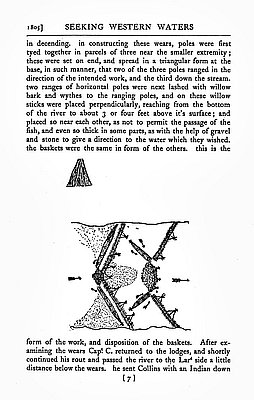
Finnish Socialist Club Picnic, Astoria, 1922
This photograph shows members of the Finnish Socialist Club picnicking in Astoria in 1922. The Finnish Socialist Club was one of Astoria’s most prominent ethnic organizations during the …
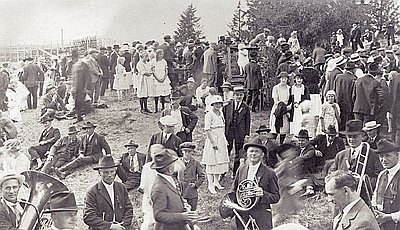
Tututni Shell Dress
This photograph of Alfred “Bud” Lane III busy at work cutting fringes from deer hide during the construction of a Tututni shell dress was taken by Nancy Nusz …
